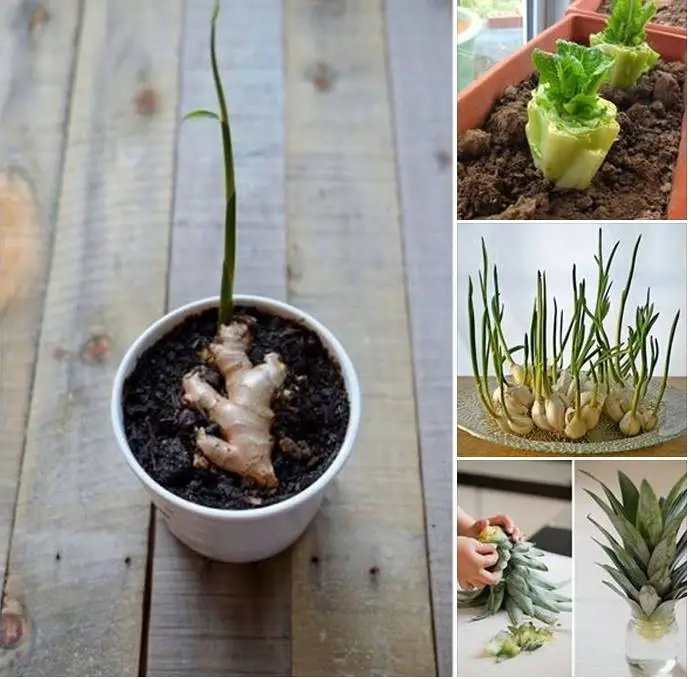
Regrowing vegetables from kitchen scraps is a sustainable and cost-effective way to have a continuous supply of fresh produce. Here are 16 vegetables that you can regrow again and again:
1. Green Onions (Scallions)
- How to Regrow: Place the white root ends in a glass of water with the roots submerged. Change the water every few days. New green shoots will appear in a few days.
- Benefit: Provides a constant supply of fresh green onions.
2. Lettuce
- How to Regrow: Place the bottom 2 inches of the lettuce stem in a bowl of water. Keep it in a sunny spot and change the water every couple of days. New leaves will start to grow in about a week.
- Benefit: Enjoy fresh lettuce leaves without buying new heads.
3. Celery
- How to Regrow: Place the base of the celery stalk in a shallow bowl of water. Change the water regularly. New growth will appear from the center in about a week.
- Benefit: Fresh celery for cooking and snacking.
4. Bok Choy
- How to Regrow: Place the base of the bok choy in a shallow bowl of water. New leaves will start growing from the center in a few days.
- Benefit: Continuous supply of bok choy for stir-fries and salads.
5. Carrots
- How to Regrow: Place the carrot tops (about an inch from the top) in a shallow dish of water. Keep them in a sunny spot. New green tops will grow in a few days.
- Benefit: Carrot greens can be used in salads, pesto, or as a garnish.
6. Leeks
- How to Regrow: Similar to green onions, place the root ends of leeks in a glass of water. Change the water regularly. New growth will appear in a few days.
- Benefit: Fresh leeks for soups and stews.
7. Garlic
- How to Regrow: Plant a garlic clove with the pointed end up in a pot of soil. Green shoots will appear in a week or so.
- Benefit: Use garlic greens or grow until the bulb is ready to harvest.
8. Basil
- How to Regrow: Place basil cuttings with the stems in water. Change the water regularly. Roots will form in about a week, after which you can plant them in soil.
- Benefit: Fresh basil leaves for cooking.
9. Mint
- How to Regrow: Place mint cuttings in water. Change the water regularly. Once roots form, plant them in soil.
- Benefit: Continuous supply of fresh mint for teas and recipes.
10. Cilantro
- How to Regrow: Place cilantro stems in a glass of water. Once roots form, plant them in soil.
- Benefit: Fresh cilantro for garnishing and cooking.
11. Parsley
- How to Regrow: Place parsley stems in water until roots form, then plant them in soil.
- Benefit: Continuous supply of fresh parsley for seasoning.
12. Potatoes
- How to Regrow: Plant potato eyes (the small sprouts that form on the surface) in soil. New plants will grow from the eyes.
- Benefit: Grow your own potatoes from scraps.
13. Sweet Potatoes
- How to Regrow: Place the end of a sweet potato in water. Roots and shoots will form. Once the shoots are about 5-6 inches long, cut them off and place them in water to form more roots before planting in soil.
- Benefit: Fresh sweet potatoes grown from slips.
14. Ginger
- How to Regrow: Plant a piece of ginger root in soil with the bud facing up. New shoots and roots will appear in a few weeks.
- Benefit: Fresh ginger for cooking and medicinal uses.
15. Onions
- How to Regrow: Place the bottom part of an onion in soil. New shoots will grow from the top.
- Benefit: Fresh onions from the old base.
16. Fennel
- How to Regrow: Place the base of the fennel bulb in a bowl of water. New green shoots will grow from the center.
- Benefit: Continuous supply of fennel greens for cooking.
Tips for Regrowing Vegetables:
- Water Quality: Use clean, filtered water to avoid contamination and encourage healthy growth.
- Sunlight: Place the containers in a sunny spot to ensure adequate light for growth.
- Change Water Regularly: Change the water every few days to prevent mold and bacteria growth.
- Transplanting: Once the roots are well-developed, transplant the plants into soil for better growth and more robust plants.
By following these simple steps, you can enjoy a steady supply of fresh vegetables from your kitchen scraps, promoting sustainability and saving money.
